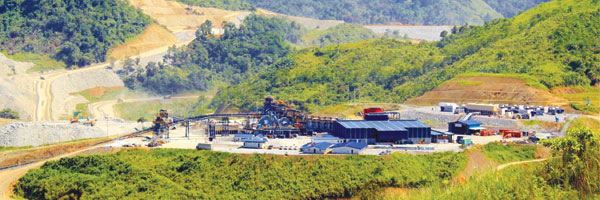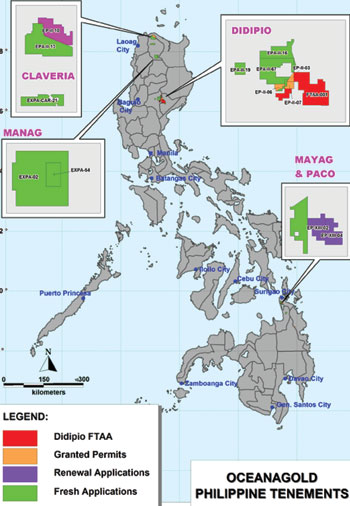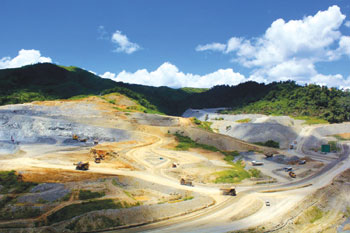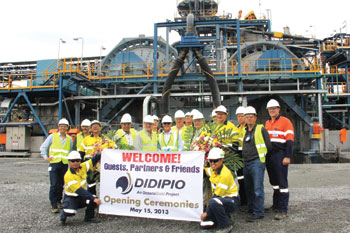By John Miller, Australian Editor
After commissioning in April 2013, the gold-copper operation quickly achieved commercial production rates three months later

OceanaGold’s Didipio gold-copper project straddles a mountainous region between Nueva Vizcaya and Quirino provinces about 270 km north of Manila.
With the Didipio gold-copper mine in northern Luzon operating above initial nameplate capacity and ramp-up continuing, OceanaGold is not resting on its laurels and is now debottlenecking the process plant to achieve an annual throughput rate of 3.5 million metric tons (mt) by the end of 2014. It is also undertaking an optimization study examining how best to maximize value from the asset, while a further study examining connecting Didipio to the national power grid is under way, providing potential for operating cost savings.
The company declared commercial production effective April 1, and ramped up to commercial production rates in a little more than three and a half months from commencement of first ore through the mills in December 2012. In the quarter, to the end of June, Didipio produced 13,676 oz gold and 5,710 mt of copper, and in the first half of 2013, it produced 20,553 oz gold and 9,373 mt of copper. Cash costs for the June quarter on a by-product basis were negative $586/oz on gold sales of 11,086 oz and copper sales of 5,073 mt.
OceanaGold’s managing director and CEO Mick Wilkes said, “We are very pleased with construction, commissioning and ramp-up. It’s a team effort and there are a lot of good people working in the business. We set ourselves realistic goals and made sure we hit them. A key factor is having very experienced people on the job who know what they are doing. Personally, I’ve been involved in building a few projects, including Sepon in Laos and Prominent Hill in South Australia, which have been equally successful in start-up, but having good people in the team makes it possible.”
He said the whole process has progressed smoothly. “We’re getting to the stage where we’ll have to put in more equipment, such as replace out some drive motors, to take the operation to an annual rate of 3.5 million mt, but this has always been planned. We are into a steady state situation and are doing studies into what the next stage will require. We have good people in our technical group who are assessing those requirements and I am confident we will meet our full ramp-up potential of 3.5 million mt by the end of next year.
“We are now running at just under 3 million mt, which is 20% above nameplate, and are confident we can take it up another notch. The plant has been designed to allow for an expansion to a 5-million mt/y operation but we will wait until we get more exploration, success and increase reserves before we commit to that. We estimate a potential expansion to 5-million mt/y to be around A$60-$70 million and we want to be able to maintain mine life at 15-20 years before we put major capital into the plant—it’s about maintaining long-life, strong, low-cost operations,” Wilkes said.
The Didipio FTAA straddles a mountainous region between Nueva Vizcaya and Quirino provinces about 270 km north of Manila. About 30 prospects are known within the FTAA, which have had varying levels of exploration over past years.
Other Prospects
“We have two very exciting tenement regions in the Philippines and are looking to start exploring them in the near future when we get our exploration permit renewals,” Wilkes said. “They are copper-gold targets in different parts of the country and are exciting long-term prospects.”
In northern Luzon, the company holds one granted exploration permit and four exploration permit applications covering two gold-copper prospects. The company holds exploration licenses, license applications and option agreements in the Surigao Peninsula area of northeast Mindanao, including Paco, Mayag, Asiga and Manhulayan. It also holds an exploration permit application covering old underground workings mined for copper in Northern Panay.
“We also have the Blackwater project in the Reefton Goldfield area of New Zealand, which we are progressing with technical studies. It is conceivably a 50,000 oz/y, high-grade, low tonnage, underground narrow-vein mine that could be built in three or four years. We haven’t made a decision on whether to proceed with a decline, but we are creating value with the project assessment and then will look at our options.
“Outside that, we are looking for an exploration front in another Southeast Asian country because we have a lack of exploration activity in the company at present, largely due to the time taken in the Philippines to receive our exploration permit renewal. Then there are the M&A opportunities that abound in the current market. It’s a pretty good time from that perspective with opportunities to pick up good quality assets,” Wilkes said.
Focus on Community
Wilkes said, “With Didipio we have been able to achieve in Southeast Asia what other companies have not, and put that down to experience, understanding the risks and knowing what’s important. I’ve worked in the region for 18 years—Papua New Guinea, Laos and now the Philippines—and the formula is the same; it’s all about the community. If you focus on the community and local stakeholders then most issues can be resolved. As long as you’ve got security of tenure and government support then the rest is up to you as mining company and developer, and you focus on the social license.
 As well as Didipio, OceanaGold has other prospects in northern Luzon and in the Surigao region of Mindanao.
As well as Didipio, OceanaGold has other prospects in northern Luzon and in the Surigao region of Mindanao.
“It is important to get that right and have the right people on the team who also understand, as they are the ones who create the relationships that lead to correct social license outcomes. Everyone who works for me is an ambassador for the company and the image they leave behind is the image people have of the company. The formula is pretty simple but the execution is more complex. If you stick to the values and ethics of the company, you get the right people and right outcomes.”
OceanaGold (Philippines) Chairman Joey Leviste said, “We try to develop relationships with all stakeholders—internally with staff and externally with communities and specifically with government at all levels. We are fortunate to have a management team and board who are sensitive to Philippine values. Management and board positions are held by people who have operated abroad and know the importance of having a social license. I am Filipino and live in the Philippines but was educated abroad so can think with a Western mind, however, my most precious academic degree is not something I studied but something I was awarded for my work in corporate social responsibility with OceanaGold.
“CSR is not just about building projects benefiting communities; it is about total relationships that benefit all parties. Proof of our ability to communicate our aims, beliefs, and the positive benefits of mining to the community and stakeholders is the fact that we are now an operating company,” Leviste said.
COO Michael Holmes said it’s important to develop a long-term relationship with the community. “We had a group doing initial ground work and exploration, then those doing building and construction, and now we have the operational team. The company had people coming and going at various stages but the relationship with the community and governments has remained strong and consistent. There’s a fundamental belief among all stakeholders within and outside the company that it is a positive thing to be doing for the company and the community. The belief within the company from people who have worked around the world and with many communities has enabled the group to speak with strength about the benefits of mining.”
Quality Orebody
Another important factor behind mining success is having a quality orebody, Wilkes said. “If you have a marginal orebody, it is difficult to make it work because it costs time and money. It is important to have a project robust enough to take the hits, whatever they are, as well as to know what is going to work and what’s not. Not all projects in Asia are buildable, simply because it is a tougher environment—you could build them in Australia but not in Asia.
“One of OceanaGold’s keys to success is that we built capability within the company to build our own projects. We are not using an EPCM contractor and outsourcing that responsibility, we do it ourselves. This has proved very successful, not just in this market which involves high costs for engineers and contractors, etc, but also in a country like the Philippines where social license is so important. We have far greater control over construction and its impacts, because people work for us, not somebody else. Being able to do it yourself is a valuable attribute for any mining company and not too many have it. This is a point of differentiation for OceanaGold.”
Stable Policy is Key
Wilkes said stable and competitive government policy is the key to the Philippines reaching its resource potential as it will attract foreign investment and build a strong, sustainable mining industry. “Government is heading in the right direction and the industry needs to get behind them by supporting their initiatives. But the government also has to be realistic with expectations about what a fair and competitive tax regime is.
“The important debates are happening in the Philippines but I hope the debates are not endless. There are some good people in government who understand what’s required and there are others who are more emotionally charged, who don’t really get the balance needed between development and environment.
 Mining under way in the pit at the Didipio gold-copper project.
Mining under way in the pit at the Didipio gold-copper project.
“The Tampakan project is a huge watershed for the Philippines. If that can be built then the mining industry can reach its full potential. It really comes back to commitment and leadership by the government,” he said.
Leviste said the current situation for new mining operations in the Philippines is a little difficult because the government is keen to review the tax regime—“a process we understand.” He said, “My concerns are that the new tax regime respects existing contracts, that it be prospective, consistent and internationally competitive so we can attract investment.
“The country will suffer if our tax regime is too excessive. There are other countries that may not be as attractive with mineral endowment but if they offer consistent policies and an internationally competitive tax regime, they will attract investment and we will miss out.
“We are pleased with our relationships with government. We could not have done what we have accomplished without support of the government through the Department of Environment and Natural Resources (DENR), Mines and Geosciences Bureau, Environmental Management Bureau, Bureau Forest Development and the various DENR units. We also have the full support of the Department of Finance, and the Department of Trade and Industry through the Board of Investments.
“The future for mining in the Philippines is good because we have the natural endowments and are moving toward being the center of attention among ASEAN countries. This will be helped by the Philippines hosting the World Economic Forum in 2020 and APEC in 2015. I think senior government officials will want to come up with an industry that is ready to take off, hopefully by 2014 and by 2015 at the latest, because it will be very difficult for us to host international conferences if we don’t put to rest some impending policy issues. I am confident that the government, working closely with Congress, will come up with a win-win solution—something we can live with and something that they can benefit from.
“It takes a little longer to achieve these aims in the Philippines because we have a government that is balancing its constituencies. There is a very strong, and I think ill-advised and ill-informed, anti-mining lobby afraid of environmental degradation. This degradation does not come from publicly listed operating companies, it comes from the small-scale, illegal artisanal miners. They are concerned about illegal logging operations—we are not illegal loggers and not even loggers, we are concerned about mining, not cutting down trees. In fact, mining companies are carrying out much of the government’s tree planting programs and we are the ones preserving the environment. We have also got to be given the chance to build the infrastructure, both physical and social, to allow development across the country,” Leviste said.
Bright Future for Copper
Wilkes believes the copper industry has a bright future with copper being a great barometer for economic growth. “With the U.S. recovery leading a global recovery, I think the copper price will track sideways if not upward in the short to medium term. There is a big new supply coming on in Oyu Tolgoi in Mongolia but that will soon be consumed by the market. One or two years and then the world will be back in deficit, so there are great opportunities for copper.
 An opening ceremony was held at the Didipio project on May 15. (Photos provided by OceanaGold)
An opening ceremony was held at the Didipio project on May 15. (Photos provided by OceanaGold)
“I see gold continuing to be volatile and uncertain, which will probably lead to a lack of investment in exploration. In the next couple of years the gold price will track sideways and that’s really because on the one hand you have a recovering U.S. economy with money coming out of defensive assets like gold and into industrial stocks, pushing the price down, yet on the other hand, you have insatiable demand for gold in all its forms in India and China, and this is price sensitive. If it goes down to $1,200 they will empty the shelves.
“You have got a price range that has developed between $1,200 and $1,400 and it will stay there in the short term but after that, you have to say it will go up again because the cycle will turn. All the cash being printed around the world has to be underpinned by an insurance policy, which is the gold market. You can only see paper currencies devaluing over time against gold, which means the gold price will increase. I’m passive about gold in the short to medium term but bullish in the long term,” Wilkes said.






